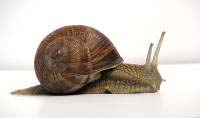Ask Mr. Sage: How to Control Snails

Q: Dear Mr. Sage,
Snails recently attacked some of my newly planted Salvias at night and destroyed lots of leaves. My Peach Scarlet Sage was really ragged.
So I placed commercial, non-toxic snail bait around the plants, but am worried about whether it is truly non-toxic. I also began handpicking snails and slugs whenever I found them and sunk some open cans filled with beer in the garden soil. All of this seems to have helped.
Can snail bait harm my plants and pets? Also, how can I nurse my chewed-up Salvias back to health?
Thanks,
Eaten Up and Fed Up
A: Dear Eaten Up and Fed Up,
Although deer and small wildlife mostly don't forage on Salvias, garden snails and slugs (terrestrial members of the Mollusk family) find them tasty and can seriously damage Salvias overnight. This is particularly true in moist coastal areas. Snails and slugs especially love the tender foliage of various Salvia Splendens cultivars, such as your Peach Scarlet Sage.
In gardens that aren't too large, nighttime and early morning handpicking is an ecofriendly, highly effective control. Collect the critters in a lidded container with a screw top; strong slugs have reportedly popped the lids off old yogurt containers. Don't release them in another part of the yard, because they'll find their way back to the garden. A good green solution is to feed them to chickens ducks. Mollusks are a good source of protein for fowl.
Your beer-trap strategy is also a good one. Just make sure that the cans or other containers are raised above ground level to avoid drowning other beneficial ground insects, including beetles that prey on snails and slugs.
Other organic strategies include:
- Spreading gritty materials -- including diatomaceous earth (a rock product) -- around affected plants, because grit is uncomfortable for soft-bodied insects;
- Creating other barriers from copper materials (tape, wire or plant stand holders), which tend to electrocute snails when their slime comes into contact with the metal;
- Cleaning up organic debris and grass near plants where mollusks can hide in the daytime; or, alternatively,
- Laying a piece of old carpet near the garden. Snails and slugs will hide under it during the daytime, and you can collect them.
As to pesticides of any kind, caution and sparing use is always required. This is true even for ones labeled as being non-toxic, such as snail and slug baits containing iron phosphate. Oregon State University reported in 2013 that even these pesticides are potentially dangerous.
Old-style snail and slug baits contain the toxic chemical metaldehyde. Producers of these traditional pesticides now must label their products as being toxic. OSU reports that a decrease in pet deaths subsequent to the new labeling law may be due to greater consumer awareness about protecting pets from metaldehyde products. The advent of iron-phosphate baits may have also decreased pet deaths as gardeners replaced methaldehyde formulations with the newer baits.
Based on OSU research published in 2013, the university hasn't linked iron-phosphate products to any pet fatalities. However, it has received reports of pets consuming the products and suffering symptoms of toxicity, such as lethargy, vomiting and diarrhea.
Although iron phosphate is sole active ingredient listed on most of these baits, they usually contain EDTA (Ethylenediaminetetraacetic acid) which activates absorption of the iron phosphate.
When consumed along with EDTA, iron phosphate interferes with digestion and causes snails and slugs to stop eating and starve. So if a child, pet or even an earthworm were to consume enough of these pellets, they might experience problems.
If you use iron-phosphate baits, avoid placing the pellets or powdered baits in mounds, which provide the opportunity for significant consumption by hungry pets or adventurous children. The best approach in using any snail or slug bait is to try to block it from the curious eyes of dogs and kids. Also, don't overuse it. You may, initially, have to apply bait every few days. Then limit its application to no more than twice a month.
Finally, you asked about how to restore health to your snail-damaged plants. You need to understand that damage causes plant growth to slow. When something as drastic as major leaf loss occurs, all the systems that help a plant grow are out of balance.
So don't overwater in an effort to stimulate new growth. Similar to animals, what goes in must come out. Water travels from the roots up to the leaves. Without sufficient foliage, a plant can't release excess moisture and nutrients to the air.
Once new growth starts appearing, it's time for selective pruning of damaged branches. Then you can slowly get back to regular watering based on your local conditions.
Although your plants need recovery time, the good news is that they likely will survive if you remain vigilant about snail removal and careful watering.
Ask Mr. Sage is a question-and-answer feature based on topics raised in calls and emails that Flowers by the Sea receives. To send a query, just click on the Ask Mr. Sage button on this page.

 Salvia splendens van houttei 'Dancing Flame'
Salvia splendens van houttei 'Dancing Flame'
Comments
There are no comments yet.